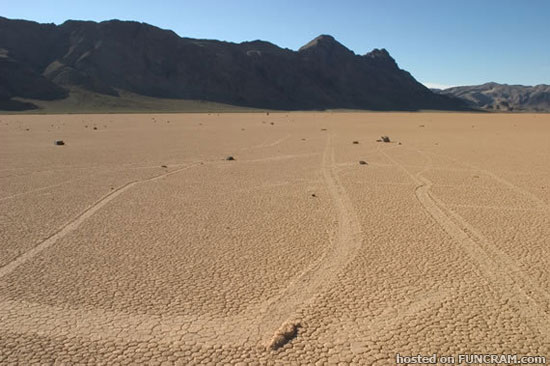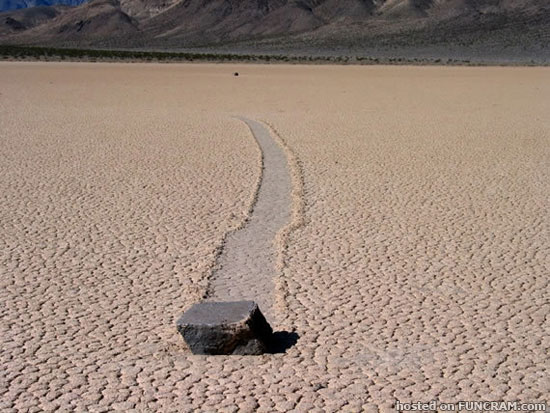

The moving rocks, also known as sliding rocks or sailing stones, are a geological phenomenon found in Racetrack Playa, a seasonally dry lake (a playa) located in the Panamint Mountains in Death Valley NationalPark, California. The rocks move across the surface of the playa, leaving long tracks behind them as they go, without human or animal intervention. They have never been seen or filmed in motion.
Racetrack rocks only move once every two or three years and most tracks last for just three or four years. Rocks with rough bottoms leave straight striated tracks while those with smooth bottoms wander.
Most of the moving stones originate from an 850 foot (260 m) high hillside made of dark dolomite on the south end of the playa, but some are intrusive igneous rock from adjacent slopes. Tracks are often tens to hundreds of feet (low to high tens of meters) long, a few to 12 inches (8 to 30 cm) wide, and typically less than an inch (2.5 cm) deep.
Most of the moving stones originate from an 850 foot (260 m) high hillside made of dark dolomite on the south end of the playa, but some are intrusive igneous rock from adjacent slopes. Tracks are often tens to hundreds of feet (low to high tens of meters) long, a few to 12 inches (8 to 30 cm) wide, and typically less than an inch (2.5 cm) deep.
Over the years there were many speculations and possible explanations made on how the stones move, ranging from supernatural to very complex. Most hypotheses favoured by interested geologists posit that strong winds when the mud is wet are at least in part responsible. But some stones weigh as much as a human, which some researchers feel is too heavy for the area’s wind to move. They maintain that ice sheets around the stones either help to catch the wind or move in ice flows.
But both theories don’t explain how two rocks right next to each other could go in two opposite directions or one could stay put while the one three times the size, doesn’t. So far every attempt of explanation has been insufficient and purely assumptive. The mystery of moving rocks is yet to be revealed.
But both theories don’t explain how two rocks right next to each other could go in two opposite directions or one could stay put while the one three times the size, doesn’t. So far every attempt of explanation has been insufficient and purely assumptive. The mystery of moving rocks is yet to be revealed.






0 Comments